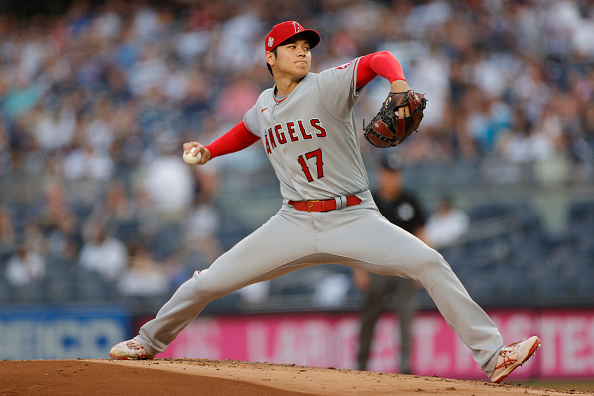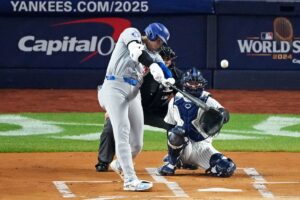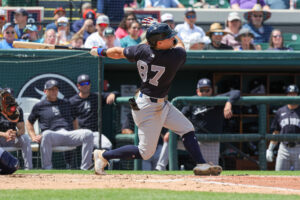Pitching has always been an Achilles’ heel for the Los Angeles Angels. The lack of pitching talent was so evident that the team drafted all pitchers in the 2021 Amateur draft. Although the fruits of this draft class won’t be seen for a few more years, the organization’s emphasis on pitching has fostered a group of exciting young rotation arms.
Shohei Ohtani
As a pitcher, Ohtani took a massive leap in 2022. The two-way star doubled his hitting production from the mound, earning Cy-young votes along the way. Ohtani’s jump in production was mostly the result of a change in pitch mix.
Shohei’s slider is statistically the second-best pitch in baseball in terms of run value. The impressive sweeping movement of this pitch allows Ohtani to throw it comfortably in any count, generating an incredibly high whiff rate.
After a dominant 2022 campaign, Shohei Ohtani is the undisputed ace of this rotation. The ultimate success of this staff relies not only on Ohtani continuing to produce but also on his ability to stay healthy throughout the season.
Tyler Anderson
The newest addition to the Angels rotation is already familiar with the Los Angeles area. The Dodgers signed Anderson to a one-year deal as a fixer-upper. Prior to his tenure with the team, Anderson hadn’t finished a season with an ERA below 4.00 since his rookie year in Colorado but finished his first season in LA with a stellar 2.57 ERA. Anderson’s success in 2022 comes as the result of a much-improved changeup.
Anderson threw his changeup nearly 25% of the time in 2021, despite it being statistically horrible. The vertical movement on Anderson’s changeup was 15% worse than the average major league changeup. The lack of drop, coupled with Anderson’s slow velocity, made it especially vulnerable. Anderson’s changeup recorded a mediocre 4-run value on his changeup, with hitters making hard contact 30% of the time.
While the positive numbers might seem like the Dodgers turned Anderson into an elite changeup machine, in reality, they only made him league average. Even in Tyler Anderson’s best season, the movement on his changeup was slightly below league average. In 2022, Anderson averaged 34 inches of drop on his changeup, 1% worse than the league average. However, this was still a significant improvement from the previous season. An enhanced changeup, coupled with a funky delivery, allowed Anderson to force weak contact. Batters had a mere .179 batting average and only a 19% Hard Hit rate against this changeup. Anderson’s ground ball rate also increased, going from 35% in 2021 to 40% in 2022.
At his best, Anderson is an all-star caliber player that pairs perfectly with the high-octane pitching of Shohei Ohtani. At his worst, Anderson is a gritty inning eater with veteran experience. If Anderson can continue to deliver this soft contact, he will be a massive addition to this Angels rotation.
Patrick Sandoval
After a breakout 2021 campaign, Sandoval went from an unproven rookie to a major rotation piece with serious expectations. Sandoval delivered in 2022, pitching to a 2.91 ERA with his first career shutout.
Like Anderson, Sandoval thrives on keeping hitters off balance with offspeed pitches and evoking soft contact. In 2022, Sandoval placed above the 75th percentile in Average Exit Velocity, HardHit%, and Barrel%. Sandoval’s ability to prevent hard contact came in part because of his increased slider usage. Sandoval used his slider a career-high 29% in 2022, making it his most used pitch. While his slider may not generate swings and misses, it does keep the ball off the barrel. Hitters had a mere .201 batting average and a lukewarm .261 SLG off Sandoval’s slider, leading the pitch to have a total run value of -9. Despite its increased usage, this slider might not even be Sandoval’s best pitch.
Sandoval’s 2022 campaign saw him toy around with a much-improved sinker. Sandoval’s sinker in 2021 was a mediocre pitch, falling below league average in both horizontal and vertical movement. Sandoval increased the horizontal movement on his sinker by nearly two inches.
Increased horizontal movement on this sinker moves the ball off the barrel, causing more weak contact. Batters only had a .227 batting average against this pitch in 2022, leading to an incredible -2.2 RV/100. Sandoval has quietly emerged as one of the best pitchers in baseball and can be expected to hold down either the second or third spot in the Angels’ rotation.
Reid Detmers
The highlight of the Angels 2022 season was undoubtedly Reid Detmers’ no-hitter against the Tampa Bay Rays. After seasons of mediocrity, SoCal fans finally had a reason to celebrate. Unfortunately, Detmers dominance didn’t last long.
Detmers struggled through the early months of his rookie season, putting up a 4.67 ERA in June, which prompted the Angels to demote him to Triple A. Fortunately, Detmers returned to form after he rejoined the major league team in June, pitching to a 3.36 ERA in the back half of the season.
Detmers, like Anderson and Sandoval, is a lefty pitcher that relies more on pitch substance than velocity. Detmer’s fastball velocity ranks in the 45th percentile of all major leaguers, but other factors give it the potential to be a plus pitch in 2023. Detmer’s fastball is incredibly efficient with an active spin of 98%. Detmers averages 10.1 inches of horizontal break on his fastball, 41% more than average. This movement on his fastball led to a Run Value of -5 in 2022, a promising sign that this pitch can compete at the major league level.
While Detmer’s improbable no-hitter may be the peak of his professional career, further development of his fastball and breaking pitches may make him a reliable caboose in this Angels rotation.
Jose Suarez
Like Detmers, Suarez bumped around between Triple-A and the Major Leagues throughout the 2022 season. After a strong season in 2021, Suarez started the new year with an abysmal 6.35 ERA in March and April. Suarez’s performance continued to fluctuate in the summer months, pitching to a 2.35 ERA in June and back again to a 6.23 ERA in July. But Suarez came alive in the final months of the season, pitching to a strong 2.51 ERA in August and a 3.60 ERA in the months of September and October.
A reason for Suarez’s monthly inconsistency is the constant tinkering of his pitch mix. For example, Suarez’s fastball usage fluctuated from 43% in April down to 31% in March and then back up again to 37% in August. Suarez’s breaking balls also follow this trend, bobbing up and down in usage throughout the season. A lack of stability in pitch usage to this degree suggests that Suarez didn’t have a reliable approach to attack hitters.
In 2021, Suarez was able to rely on his above-average changeup, which recorded a run value of -13. In 2022, however, Suarez’s changeup recorded a run value of 0. The pitch also saw significant regression in batting average against, HardHit%, and Whiff%. Despite this regression, Suarez finished the season as a league-average pitcher.
While Suarez’s 2022 campaign may have fallen short of expectations, his late-season surge is a promising sign of his development. If Suarez can continue to put up the K% and BB% we saw in late August, he will be a crucial inning-eating piece in the back of an Angels rotation looking to compete for a playoff spot.
Main Photo:
Players Mentioned:
Shohei Ohtani, Tyler Anderson, Patrick Sandoval, Reid Detmers, Jose Suarez






